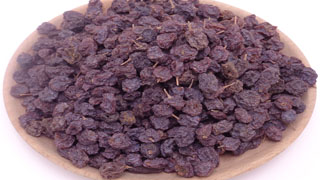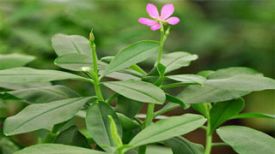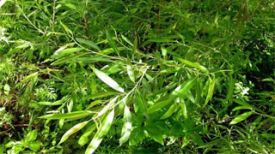
Nicknames: Putao, Putao
Harvesting and processing: Harvesting fruits in summer and autumn when they are ripe, fresh or air dried.
Medicinal parts: Mature fruit
Origin: National
Subject: Vitaceae
Original plant: Grape
Plant condition: tall entwined vines
The young stem is bald or slightly covered in soft hairs; The tendrils have forked branches and are opposite to the leaves.
Mutual growth of leaves; The petiole length is 4-8cm; The leaves are paper, round ovate or circular, 10-20cm wide, often 3-5 lobed, heart-shaped at the base, with coarse and slightly sharp teeth at the edges, and often densely covered with spider silk like hairs below
Heterogeneity of flowers, different plants; The inflorescence is large and long, opposite to the leaves, and covered with sparse spider like soft hairs; Inflorescence stalk without tendrils; Calyx extremely small, cup-shaped, with a full or indistinct 5-toothed cleft; Petals 5, yellow green in color, with the tip glued together but not unfolded, the base separated, and the whole piece falls off in a cap like shape when flowering; Stamen 5; The flower disk is raised and composed of 5 glands, with the base fused with the ovary; Ovary 2-chambered, style short, conical.
Berries are oval to oval in shape, rich in juice, purple black or red with a bluish tint when ripe, and coated with wax powder. The flowering period is in June, and the fruiting period is from September to October.
Characteristics of grape medicinal herbs: The fresh product of this product is round or oval in shape, and the dry product is wrinkled, with a length of 3-7mm and a diameter of 2-6mm. The surface is light yellow green to dark red. There are residual column bases at the top, slightly protruding, and fruit stalk marks at the base, some of which have residual fruit stalks. Slightly soft in texture, easily torn, rich in sugar, with a slight odor and a sweet but slightly sour taste.
High quality products with a reddish brown color, neat grains, and no impurities are preferred
Poor quality products with thin and tattered grains are secondary.
Grape medicinal properties:
【 Original text of this sutra 】 Sweet and smooth in taste, with a main effect on dampness and numbness in the muscles and bones. It can invigorate qi and strengthen the mind, making people fat, healthy, and able to endure hunger, wind and cold. Long term consumption can lighten the body, prevent aging, and prolong life. It can be made into wine.
【 Origin 】 It can be found everywhere, with many plantations located in mountainous areas, and is abundant in various countries such as the United States and France.
[Taste] Sweet and astringent in taste, mild in nature, non-toxic.
【 Indications 】 Pu Grape can nourish the body, invigorate qi and nourish blood, treat dampness and numbness in muscles and bones, and is good for making wine.
【 Additional entry 】 Drizzle water and urinate easily.
[Zhen Quan] Remove intestinal water, adjust the middle to treat gonorrhea.
Su Song: When acne does not appear, it has the effect of eating or drinking alcohol.
【 Spiritual fetus 】 Tonifying muscles and bones, nourishing muscles.
[Dosage] It is commonly used as food and has no specific dosage when used as medicine.
[Taboo] Eating too much can make one feel frustrated and dull. Southeastern merchants are prone to illness and heat when eating, while people in the northwest eat unharmed.
【 Taste 】 Sweet; Acid; flat
[Guijing] Lung; Spleen; Kidney meridian
【 Functions and Indications 】 Tonifying Qi and Blood; Strong muscles and bones; Easy urination. The main qi and blood are weak; Cough due to lung deficiency; Palpitations and night sweats; Irritable thirst; Rheumatoid arthritis and pain; Gonorrhea; Not swollen; Impermeable acne rash
[Usage and Dosage] Oral administration: decoction, 15-30g; Or mash the juice; Or boil ointment; Or soak in wine. External use: appropriate amount, soak in wine and rub; Or mash the juice and swallow it; Or research and scatter.
[Attention]
Meng Qiao: Unable to eat too much, it makes one feel frustrated and dull.
2. "Ben Jing Feng Yuan": Eating too much can cause diarrhea.
3. "Essentials of Medical Forestry Compilation": Eat more to prevent internal heat.
【 Discussions from Various Schools 】
1. The Classic of Chinese Medicine states: It is mainly used to treat dampness and numbness in the muscles and bones, to nourish qi and increase strength, to strengthen the mind, and to make people fat, healthy, and able to endure hunger and cold winds. Can be made into wine.
2. "Bielu": Drizzle water and urinate easily.
3. "Treatise on Medicinal Properties": Eliminate intestinal dampness, regulate the middle to treat gonorrhea, and promote urination.
4. "Compendium of Materia Medica": For those who are unable to develop sores and rashes during treatment, they should drink wine.
5. "Dian Nan Ben Cao": It can greatly nourish qi and blood, relax muscles and activate collaterals. Soak it in wine and take it. Treat Yin Yang deficiency syndrome and also treat night sweats deficiency syndrome. Juice, treat cough.
6. "Explanation of Materia Medica in Southern Yunnan": To treat acne and toxins, the fetal qi should be flushed upwards. Boil the soup and drink it immediately.
7. "Hundred Grass Mirror": Treating damp and painful muscles and bones. Lishui is very efficient, removing swelling all over the body.
8. "Herbal Medicine Renewal": Warm the stomach and invigorate the spleen, treat lung deficiency, cold cough, and promote blood accumulation and necrosis.
9. "Suixi Ju Dietary Guidelines": Tonify Qi, nourish Kidney Fluid, nourish Liver Yin, strengthen muscles and bones, quench thirst, and ensure a safe pregnancy.
10. "Xinjiang Medicinal Materials": Detoxification, dispersing.
11. "Luchuan Materia Medica": Nourishes and strengthens the body, replenishes blood, strengthens the heart and diuresis. Treat lower back pain, stomach problems, mental fatigue, blood deficiency and heartbeat. "


